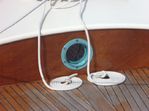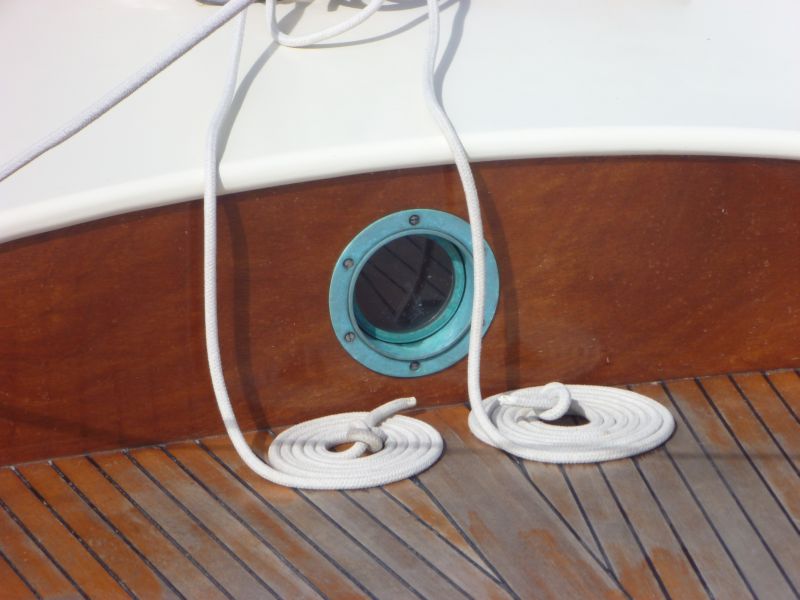Aesthetics and performance
Preparation
A successful repair, hull polishing or painting is all down to the preparation. It is estimated that represents 75% of the working time. On the areas outside the water a lot depends on the material of the shell.
Mono or bi-component paint?
Mono composition paints are easy to use and their solvent evaporation drying leaves a residue far superior to conventional types. They posses a great flexibility are well suited to all bases and strongly recommended for wood. Dual component paints are highly resistant to abrasion, UV and chemical agents. They provide a long lasting finish. Their polymerisation drying leaves a harder residue than classic types.
Wood boats
The wood is prepared by sanding. Check that it is dry enough and that the paint is compatible. To paint a traditional wood boat, one must use, to avoid cracks, monocomponent paint. More flexible, it is suitable for most work on wood. It is always advisable to first apply the product for treating wood on a small section to ensure that it does not have undesirable effects.
Steel boats
For steel the best abrasive is a jet (sandblaster.) Aluminum must be thoroughly degreased and then receive a chemical pretreatment or sanding.
Polyester boats
For gel coats, you must first remove all traces of releasing agent (new boat), fats or waxes (old boat) and sand them. If there are deep scratches or splinters, apply a polyester filler, then a gelcoat to finish. For the application of paint (undercoat and finishing), take a product right for the hull and strictly follow the stated procedure.

Steel boats
For steel the best abrasive is a jet (sandblaster.) Aluminum must be thoroughly degreased and then receive a chemical pretreatment or sanding.
Polyester boats
For gel coats, you must first remove all traces of releasing agent (new boat), fats or waxes (old boat) and sand them. If there are deep scratches or splinters, apply a polyester filler, then a gelcoat to finish. For the application of paint (undercoat and finishing), take a product right for the hull and strictly follow the stated procedure.


Antifouling and ballast
Below the waterline if one wishes to remove old antifouling one can sand the hull but the best solution is the water jet (hydrogommage.) If the ballast is connected and shows signs of rust, eliminate the water (drying) and strip with a sander. Passivate immediately after drying. Then apply a coat of epoxy primer, five coats of undercoat and finish with two coats of antifouling.
Read the instructions
Covering power of paint is given on the label. Generally, performance is related to the thickness of paint applied per m²: not enough, the protection will be insufficient too much and there will be drips and drying problems with the risk of creating a soft film.
How to calculate the surface?
These formulae give a good estimate of the surface in m².
LOA = length overall
LWL = waterline length
B = Beam
D = draft.
For the hull of the flat-bottomed boats such as motor boats, draft boats and keel, the
surface is given by:
LWL x (B + D)
On a sailboat cruise draft:
0.75 x LWL x (B + D)
On a sailboat regatta keel narrow and deep:
0.50 x LWL x (B + D)
For topsides:
(LOA + B) x (2 x the average freeboard).
For bridges:
(LOA x B) x 0.75 (deduct area of the cockpit.)
LOA = length overall
LWL = waterline length
B = Beam
D = draft.
For the hull of the flat-bottomed boats such as motor boats, draft boats and keel, the
surface is given by:
LWL x (B + D)
On a sailboat cruise draft:
0.75 x LWL x (B + D)
On a sailboat regatta keel narrow and deep:
0.50 x LWL x (B + D)
For topsides:
(LOA + B) x (2 x the average freeboard).
For bridges:
(LOA x B) x 0.75 (deduct area of the cockpit.)
Crane
Setting in the water or putting dry in the hold, AD has the reactive, professional solution and at any time! With performance boat lifts and qualified and available technicians AD guarantees a flawless, safe performance for all your crane needs!
Professional Advice
“Our in-store specialists are trained to permanently provide the best advice for this very specific work.”
